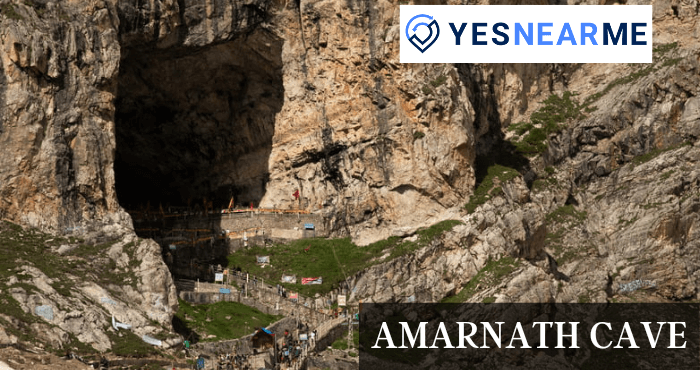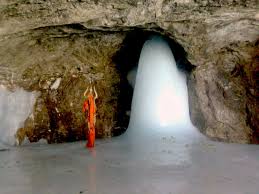
Table of Contents
Amarnath Cave

Amarnath Cave: A Sacred Pilgrimage in the Himalayas
The Amarnath Cave is one of the most revered and spiritually significant pilgrimage sites in India. Located in the Indian state of Jammu and Kashmir, this sacred cave has long been associated with the worship of Lord Shiva, one of the principal deities of Hinduism. Nestled at a high altitude of approximately 3,888 meters (12,756 feet) in the remote and rugged mountains of the Himalayas, Amarnath Cave draws thousands of devotees every year, particularly during the holy month of Shravan, which typically falls between July and August. It is a journey of both physical endurance and spiritual fulfillment, and for many, a pilgrimage to the Amarnath Cave is an experience of a lifetime.
This article will explore the history, mythology, significance, geography, challenges, and modern-day importance of the Amarnath Yatra (pilgrimage) and the Amarnath Cave.
Historical Significance of Amarnath Cave
The Amarnath Cave has been a site of worship for thousands of years. While the exact date of its discovery remains uncertain, historical and archaeological evidence suggests that it has been a place of pilgrimage since ancient times. The cave’s significance was noted in Hindu texts, and it has been a destination for devotees seeking divine blessings for centuries.
The journey to Amarnath is a physically demanding and spiritual journey, not only for its distance and harsh terrain but also for the deep reverence that surrounds the place. Its association with Lord Shiva, the god of destruction and transformation, and his consort Parvati, has ensured its place in Hindu mythology and religious traditions.
Mythological Importance of Amarnath Cave
According to Hindu mythology, the Amarnath Cave holds the secret of immortality and divinity. The story behind the cave is rooted in the ancient legend of Lord Shiva and his consort Parvati. The myth goes that once, Parvati, eager to know the secret of immortality, asked her husband Shiva about it. In response, Lord Shiva decided to narrate the story to Parvati in a secluded place, away from the world.
In their journey to find a hidden, secure location, they reached the Amarnath Cave, where Lord Shiva began telling the story of immortality. It was here that Shiva revealed the secret to Parvati, while various divine animals (including his vehicle, the Nandi bull) and even the moon were present, listening to the conversation. Lord Shiva, as part of the process of revealing the secret of immortality, instructed Parvati on the nature of the world, life, and death.
In honor of this event, the ice formation inside the Amarnath Cave, known as the Shivling (the phallic symbol of Lord Shiva), is believed to be a manifestation of Lord Shiva himself. The Shivling is said to form naturally every year, increasing in size during the full moon of the Shravan month, growing as the summer progresses, and shrinking as the winter months approach. The formation of this Shivling represents the cyclical nature of life and death and is the focal point of devotion during the Amarnath Yatra.
The belief surrounding the Amarnath Cave and its sacred ice Shivling is central to the pilgrimage, with devotees believing that visiting the cave and offering prayers to Lord Shiva can bring spiritual enlightenment, protection, and the divine blessing of immortality.
Geography and Location of Amarnath Cave
The Amarnath Cave is situated in the Pahalgam area of the Anantnag district in the Jammu and Kashmir region of India. The cave is perched at an altitude of 3,888 meters (12,756 feet) and is accessible by foot or horseback through a difficult and challenging path. It lies deep within the Himalayan range and is surrounded by snow-capped peaks, lush green valleys, and glacial streams, making the journey an awe-inspiring adventure.
To reach the cave, pilgrims typically follow one of two routes:
-
The Pahalgam Route: This is the longer and more popular route to the Amarnath Cave, covering a distance of approximately 45 kilometers. Starting from Pahalgam, a picturesque town known for its scenic beauty, the route takes pilgrims through the Chandanwari pass, Sheshnag Lake, and Panchtarni before arriving at the Amarnath Cave. The trek is strenuous, especially at high altitudes, and requires physical stamina and careful acclimatization to avoid altitude sickness.
-
The Baltal Route: This route is shorter (approximately 14 kilometers) but is considered more difficult due to its steep inclines. Pilgrims using this route often begin the journey from Baltal and pass through Domel before reaching the Amarnath Cave. While the journey is shorter, it is still challenging due to the rugged terrain.
The Amarnath Yatra: A Pilgrimage of Faith and Endurance
The Amarnath Yatra is a sacred pilgrimage that takes place annually, typically during the month of Shravan (July and August), coinciding with the Hindu calendar’s monsoon season. The pilgrimage is undertaken by devotees from all parts of India and beyond, who travel to the Amarnath Cave to worship the natural ice Shivling. The yatra is conducted by the Jammu and Kashmir government in cooperation with various religious organizations.
The yatra lasts for approximately 40 days, and during this period, thousands of pilgrims make their way to the cave to offer prayers and seek the blessings of Lord Shiva. The pilgrimage begins with a ceremonial Darshan (viewing of the Shivling), where pilgrims first pay homage to the deity before embarking on the trek.
The Shivling itself is a naturally formed ice formation that grows to a height of approximately 1.5 meters during the peak of the yatra, reaching its largest size on the full moon night of Shravan. The ice formation is regarded as a physical manifestation of Lord Shiva, and it is believed that devotees who visit the cave and offer their prayers receive the divine grace of Lord Shiva.
Despite the arduous nature of the journey, the pilgrimage holds immense significance for Hindus. For many, the yatra is an expression of devotion, faith, and perseverance. The long trek is seen as a means of purifying the body and soul, and the challenges faced along the way serve as a reminder of the trials and tribulations of life, encouraging pilgrims to embrace the divine with patience and humility.
Challenges of the Amarnath Yatra
The Amarnath Yatra is a physically demanding and challenging pilgrimage. The difficult terrain, unpredictable weather conditions, and high altitude make the journey perilous, especially for those unaccustomed to trekking at high altitudes. The trek involves steep ascents, narrow mountain paths, and frequent exposure to cold temperatures and snow.
Some of the major challenges faced by pilgrims during the yatra include:
- Altitude Sickness: Due to the high altitude, many pilgrims suffer from altitude sickness, which can cause symptoms such as dizziness, nausea, and shortness of breath. Proper acclimatization and rest are essential to avoid these symptoms.
- Harsh Weather Conditions: The weather in the region is unpredictable, with sudden rain, snowfall, and freezing temperatures. Pilgrims are often exposed to these conditions, which makes the journey even more difficult.
- Physical Endurance: The long and steep trek requires significant physical strength and stamina. Many pilgrims, particularly the elderly and those in poor health, find the journey taxing.
- Lack of Basic Amenities: Basic facilities such as medical assistance, food, and shelter are limited along the route. Pilgrims must carry their own supplies and prepare for difficult conditions.
Despite these challenges, the Amarnath Yatra is undertaken by thousands of devotees each year, driven by a deep sense of spiritual devotion and reverence for Lord Shiva.
Modern-Day Importance of Amarnath Cave and the Yatra
In recent decades, the Amarnath Yatra has grown in prominence, both in terms of the number of pilgrims and its cultural and economic impact. The Jammu and Kashmir government, along with various religious organizations, has worked to make the yatra safer and more accessible by improving infrastructure, such as roads, health facilities, and campsites along the trekking routes.
The yatra has also become an important event for tourism in the region, drawing not only religious pilgrims but also tourists interested in the natural beauty of the area. Local communities benefit from the influx of pilgrims, as businesses related to hospitality, transportation, and supply services experience a surge in demand.
Moreover, the Amarnath Cave and its associated pilgrimage are seen as a symbol of religious unity, as people from diverse backgrounds and regions come together to participate in the sacred journey. It serves as a reminder of the power of faith, the importance of perseverance, and the spiritual connection between humanity and the divine.
Amarnath Cave Temple History
The book Rajatarangini refers to Krishaanth or Amarnath . It is believed that in the 11th century CE.
Queen Suryamati gifted trishulas, banalingas and other sacred emblems to this temple .
Rajavalipataka, begun by Prajna Bhatta thus contains detailed reference to the pilgrimage to Amarnath Cave Temple .
In addition, there are further references to this pilgrim in many other ancient texts.
According to legend thus sage Bhrigu was the first to have discovered Amarnath .
A long time ago it is believed that the valley of Kashmir was submerged underwater thus and Sage Kashyapa drained it through a series of rivers and rivulets.
As a result, when the waters drained , Bhrigu was the first to ha e darshan of Shiva at Amarnath .
Thereafter , when people of heard of the lingam thus it became an abode of Shiva for all believers and the site of an annual.
Pilgrimage, traditionally performed by lakhs of people in July and August during the Hindu Holy month of Savan.
Conclusion
The Amarnath Cave stands as a beacon of faith and devotion, attracting millions of pilgrims and seekers of divine blessings every year. The mythology, history, and spiritual significance of the cave make it a profound and transformative destination for Hindus, symbolizing the eternal relationship between humanity and the divine.
IF YOU LIKE THESE ARTICLE
DO CHECK THESE ARTICLE TOO
BEST PLACES TO VISIT IN LEH LADAKH
FOR MORE INFO
